
Franz Kröger
SOCIAL AND CULTURAL CHANGE FROM A TO Z
Introduction: Many learned books have been written on globalization, social and cultural change, economic innovations etc. In 2001 Eugene L. Mendonsa published a book on Continuity and Change in a West African Society – Globalization’s Impact on the Sisala of Ghana. Most of its contents may be applicable also to the situation of the Bulsa. The [Bulsa] District Human Development Report 2004 (hence: DHDR) contains data on different fields of social development for the interested reader (See review in BULUK 5).
The following list is not intended to give be a contribution to the scientific discussion of change, but rather to focus on some aspects in the light of the personal experience of the author, many of which are inaccessible to the sociologist, who only works with questionnaires.
AIDS / HIV: According to the District Human Development Report 2004 there were 19 cases of HIV / AIDS reported in the Bulsa District. The numbers of new cases for the preceding years were: 2000: 30; 2001: 67; 2002: 51 and 2003: 48.

Buses and Transport: The time when overcrowded open pickups transported men and animals from one village to another, seems to be over (see photo in BULUK 1, p. 20). Pickups and mammy-lorries have been replaced by buses. Going to the South was a problem for the Bulsa of the past. Today there is even a State Transport bus-line in Accra for a direct connection to Fumbisi (and back).
Although the buses of Bulsa District are still overcrowded in the rush hours, travelling has become more comfortable. One bus even offers its passengers a TV programme (see photo).
Cement: Cement, available on markets in different quantities, from bags to cups, is now used in addition to traditional building materials. Some decades ago, due to its relatively high price, it could only occasionally be used for surfacing certain spots of the inner courtyard, e.g. at its entrance or in front of a house. Today, most courtyards and many houses built with dried mud bricks, have cement plaster. On walls, it has partly displaced the Acoal-tar@ plaster, which was so fashionable twenty years ago.
It is worth examining how far cement mortar and plaster are tabooed for sacred mud buildings. Ancestral shrines (bogluta) may be plastered with cement, while (in Wiaga) an ancestral house (dalong or kpilima dok) should still be a flat-roofed round house built in the wet mud technique without any addition of cement.
 Divination: There have not been any essential changes in the procedure of a divinatory
session in recent times and the number of clients has probably not drastically decreased. Even
some Christians try to solve their problems with the help of the Adivining wand@. The
contents of the diviner=s bag, however, have been adjusted a little to modern times. You can
find, for example, code-objects of the following forms and meanings: a small medicine bottle
with the meaning Ago to a modern hospital for treatment!@; a ball-point pen (see photo)
meaning Ayou have problems with administrative authorities or with schools@; a yarn spool
meaning Alorry@, Ayou will travel by lorry or bus@.
Divination: There have not been any essential changes in the procedure of a divinatory
session in recent times and the number of clients has probably not drastically decreased. Even
some Christians try to solve their problems with the help of the Adivining wand@. The
contents of the diviner=s bag, however, have been adjusted a little to modern times. You can
find, for example, code-objects of the following forms and meanings: a small medicine bottle
with the meaning Ago to a modern hospital for treatment!@; a ball-point pen (see photo)
meaning Ayou have problems with administrative authorities or with schools@; a yarn spool
meaning Alorry@, Ayou will travel by lorry or bus@.

Dolls and other toy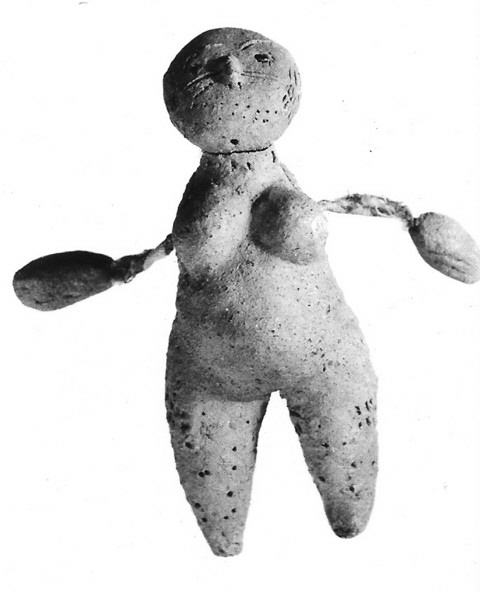 s: Most Bulsa boys in the shepherd-age are fond of moulding dolls,
animals, lorries and other traditional and modern objects
in clay. Producing these things is probably
more fun and takes more effort than playing with them, for the unbaked toys are very fragile
(cf. Kröger 2001, p. 744-747).
s: Most Bulsa boys in the shepherd-age are fond of moulding dolls,
animals, lorries and other traditional and modern objects
in clay. Producing these things is probably
more fun and takes more effort than playing with them, for the unbaked toys are very fragile
(cf. Kröger 2001, p. 744-747).
These days plastic dolls, made in East Asia, can be bought on Sandema market. It is to be hoped that they will not replace the young boys’ creative activities and their artistic clay products.
Emancipation of women: In the polygynic marriage system without bride-wealth, as
practised by the Bulsa,
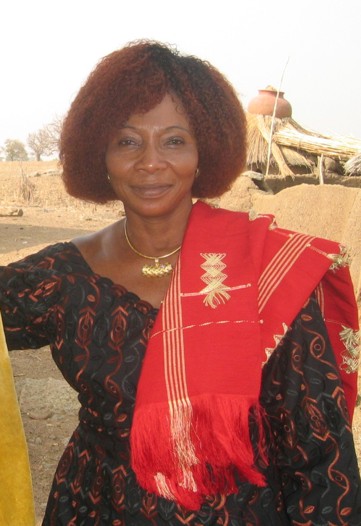 there
has never been a strong suppression of women by men. Women have always been
allowed to move freely, to travel to the south or visit relatives whenever they
liked, to start any kind of business to earn some additional money, and to leave
their husbands when they did not feel happy in his family. The numbers of girls
going to school and women converti
there
has never been a strong suppression of women by men. Women have always been
allowed to move freely, to travel to the south or visit relatives whenever they
liked, to start any kind of business to earn some additional money, and to leave
their husbands when they did not feel happy in his family. The numbers of girls
going to school and women converti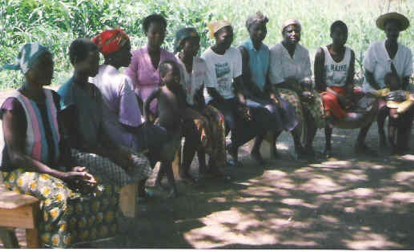 ng to Christianity exceeds that of boys and
men. There have always been great Bulsa women in politics, and also at the
moment the MP of Bulsa North Constituency is female
(Ms Agnes Chigabatia, see photo).
ng to Christianity exceeds that of boys and
men. There have always been great Bulsa women in politics, and also at the
moment the MP of Bulsa North Constituency is female
(Ms Agnes Chigabatia, see photo).
Nevertheless, women play a role in traditionally male-dominated institutions and are increasingly adopting behavioural roles traditionally ascribed to by men. Girls and women are trying to ride a bicycle, or the women from a compound are having a meeting (men being excluded) in front of the compound (see photo). This takes place, however, under a tree, not in the kusung, which is still reserved for the old men’s meetings.
Fax: Mail correspondence between Northern Ghana and Europe has improved very much in recent years. Whereas in the 1980s an air-mail letter often took over 4 or 5 weeks to reach its destination, at the moment only 20 days or less are needed. While telephone calls from or to mobile phones are still quite expensive, an economic alternative is the fax. Sent from Sandema it will arrive in a European office or living room in one minute.
Finials: Perhaps one day roof-finials will help date old photos of the inclusion of the Bulsa territory in the globalization process. The traditional way is to use a ceramic vessel, with or without bottom, to give additional hold to the top of a conical straw roof. Even thirty years ago you could see old white enamel basins without bottoms being used to fulfil this function. Today, ceramic finials have not disappeared, while a lot of other types are being used, e.g. bicycle rims or tyres, even car tyres.
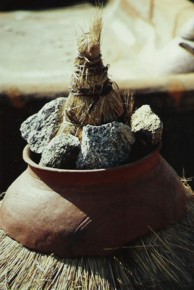
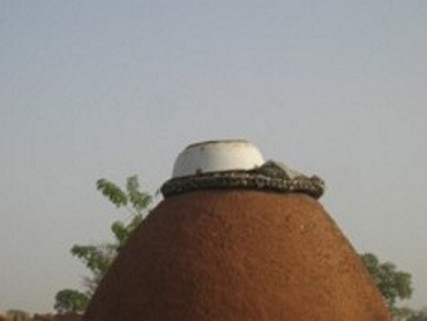


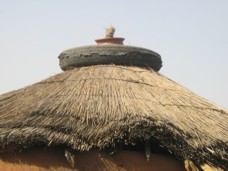
Globalization: For several years now, especially after the economic upswing in the 1990s,
Bulsa markets and
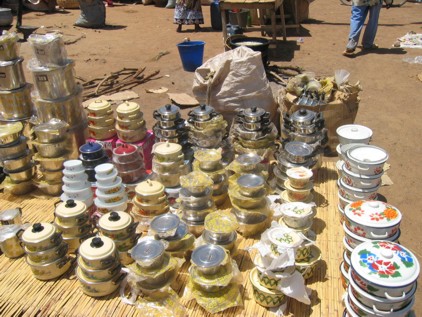 regional markets frequented by Bulsa, ha
regional markets frequented by Bulsa, ha ve been offering products from
various parts of the world: plastic, aluminium and enamel ware from East and Southeast Asia
(see photo of Fumbisi market), cloth from Southern Ghana, electronic and photographic
equipment from Japan, second-hand clothes from Europe and the USA. Even German Kölln
oat flakes have been seen on Sandema market. The big world map at Wiaga market (see
photo), provided by the US Peace Corps (but certainly in agreement with the local people),
may be regarded as a symbol of the new feeling of being Aglobalized@.
ve been offering products from
various parts of the world: plastic, aluminium and enamel ware from East and Southeast Asia
(see photo of Fumbisi market), cloth from Southern Ghana, electronic and photographic
equipment from Japan, second-hand clothes from Europe and the USA. Even German Kölln
oat flakes have been seen on Sandema market. The big world map at Wiaga market (see
photo), provided by the US Peace Corps (but certainly in agreement with the local people),
may be regarded as a symbol of the new feeling of being Aglobalized@.
Health: According to the DHDR 2004, the Bulsa District had one hospital (with one doctor), four health centres, two clinics, three CHPS (Community Health Planning Services) centres and 74 outreach points in 2003 (p. 51). These institutions do not offer sufficient health service for all Bulsa, for “only 21% of households are estimated to be less than 30 minutes away from a health facility” (p. 53). “The majority of the population therefore rely on traditional health practitioners”. Besides, several Christian churches and movements have made “healing” an important part of their activities.
[Cf. also “Aids” in this list; “History of the Wiaga Clinic” in BULUK 4, p. 49; “A Visit to a meeting of Akawuruk and her adherents” (ibid., p. 54) and numerous entries about vaccinations, health training courses and educational work among the population in the lists of “News from Buluk”, resp. “Events” (BULUK 1-4).
Hotels: see planned article (BULUK 5) about the “Good Family Lodge”
 House-numbers: Before the population census of 2000 all compounds and independent
houses were numbered to guarantee complete registration. The numbers were painted in
white on the walls near the entrance gateways. After the completion of the census the
numbers were accepted as their “house-numbers” by the inhabitants. They do, however, not
(yet) appear in the addresses and are not requested in any administrative questionnaires.
House-numbers: Before the population census of 2000 all compounds and independent
houses were numbered to guarantee complete registration. The numbers were painted in
white on the walls near the entrance gateways. After the completion of the census the
numbers were accepted as their “house-numbers” by the inhabitants. They do, however, not
(yet) appear in the addresses and are not requested in any administrative questionnaires.
Individualisation: Bulsa social life and traditional work was based on a functioning community. Together with economic development, there is a strong tendency towards individualization in traditional groups of various sizes and functions. In the past, the inhabitants of a compound formed “one big family” (which does not mean that there were no potential conflicts among its members). The head (yeri nyono) was regarded as the extreme authority, who had power over and was responsible for the nuclear families (e.g. of his sons). At least part of the wages and salaries earned outside the domestic lineage was to be given to the yeri nyono, who, on his part, paid all extraordinary expenses of the inhabitants, e.g. the costs for hospital, school, law-courts etc. Today the married sons of the head have their own households and administer their own income and expenses.
A certain individualisation can also be observed with regard to crafts. The traditional mode of building houses is the wet mud-ball technique, which can only be employed when the work is done on a community basis. Today most houses are built of sun-dried mud bricks, and it is no problem for a single man to build his house in this way.
Industry: There are no factories in the Bulsa District, and mechanisation of some crafts has just started (e.g. with the blacksmiths of the Kalijiisa Co-operative Multi-Purpose Society, Sandema). On future prospects of a moderate industrialisation, the Bulsa District Human Development Report 2004 remarks (p. 79):
“In terms of non-farm income-generating activities, there is a potential for at least one large-scale factory producing shea butter or buying from women=s group and reprocessing for export... The economic and physical infrastructure of the Builsa District is not attractive for private investment. Efforts must be made...”
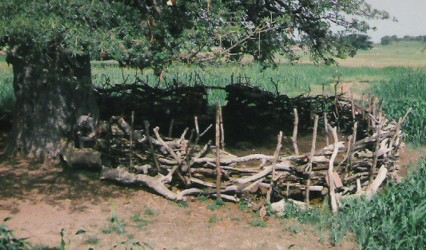
Kraals: Every evening in the rainy season, cattle and sheep, which graze in the bush land during daytime, are driven into the cattle yard within the Bulsa compound, where they are safe from theft. Today many young people (well-dressed and with polished shoes) complain that after rain showers it is difficult to get to their own quarters through the wet mud and cow-dung. Therefore several farmers have started building cattle-kraals outside the compound.
Libraries: The District Library is in the administrative block of Sandema and consists of
several ro oms with
oms with
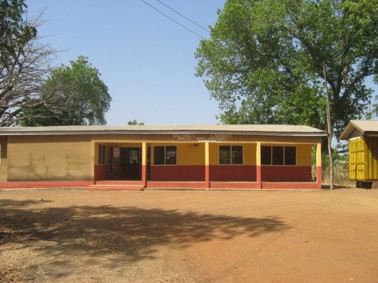
hundreds of books comprising all fields of literature from novels and youth literature to computer science The printed editions of BULUK can also be read here.
There is a Parish Library in Wiaga and another public library is planned by people of the chief=s house. It should be mentioned that some educated men have their own extensive private libraries. - There was no information available about libraries in other Bulsa villages.
Motorcycles (and other vehicles): Their numbers among the Bulsa have increased tremendously in recent years. A visitor to Ouagadougou (Burkina Faso) in the 1980s and 1990s was struck by the great number of “mobilettes” (mopeds), perhaps the most common means of transport for the middle class. Among the Bulsa (and in the whole of Northern Ghana?) the moped has never been very popular. After a phase in which bicycles were most commonly seen, the motorbike has gained great popularity among wealthier people. Passenger cars owned by private persons who do not use them for business are not as common as in other parts of Ghana. But some Bulsa have been able to buy taxis, which is a great relief for visitors who do not want to travel in crowded buses (cf. article “Buses”).
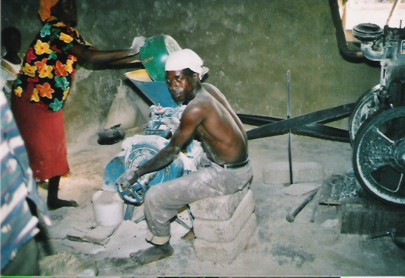
Nika-nika (grinding-mills): If you ask a Bulsa housewife “Which is the most exhausting of your daily chores?” she will probably answer “Grinding in the nanzuk (grinding-room)”. The monotonous sound of the grinding stones, accompanied by the beautiful songs of the drudging woman are certainly more pleasant for an outsider than the loud noise of the nika-nika diesel engine. For many Bulsa housewives, however, the modern grinding mill has become a considerable relief. The number of these mostly privately owned mills has increased, which means that more and more women can afford to pay for the use of this technical household-help. At the moment, there is no alternative to the nika-nika, but the time will come when it will be replaced by electric mills.
Pollution: As recently
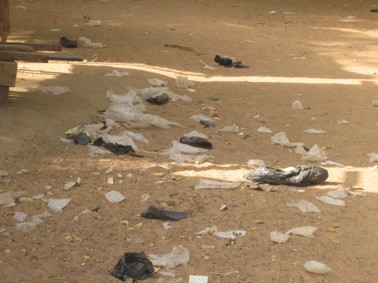 as the 1980s a European visitor was fascinated by the way the Bulsa
solved their environmental p
as the 1980s a European visitor was fascinated by the way the Bulsa
solved their environmental p roblems. Nearly all spoilt or broken utensils were
recycled. A broken ceramic cooking pot could be treated to be used as a roof finial, a dog=s
trough or a stand or lid of another pot. Smaller shards could be used for mosaics on the floors
of inner courtyards or could be ground to function as temper for a potter=s clay. Empty milk
tins served as containers in the household or were given to teenage boys, who worked them
into wonderful tin carts and other toys. House-walls became fertile farmland again after a
compound had been given up.
roblems. Nearly all spoilt or broken utensils were
recycled. A broken ceramic cooking pot could be treated to be used as a roof finial, a dog=s
trough or a stand or lid of another pot. Smaller shards could be used for mosaics on the floors
of inner courtyards or could be ground to function as temper for a potter=s clay. Empty milk
tins served as containers in the household or were given to teenage boys, who worked them
into wonderful tin carts and other toys. House-walls became fertile farmland again after a
compound had been given up.
But with the introduction of tar and cement the first environmental problems arose. Where were these to be disposed of? Today, black plastic bags, which are perhaps too freely given away at market stalls, have become an environmental problem. Unlike in Europe, they are not recycled or used a second time for shopping, but are thrown away onto market squares, roads and farmland. Goats like to eat the small salt bags (with some remainders of the salt in it), which often leads to illness or death. Some innovative people have discovered, however, that cut-up bags can be plaited into strong ropes, e.g. for drawing water (see photo).
Public refuse disposal has not been sufficiently developed. At Fumbisi, there is a rubbish container (see photo), but this evidently has not eliminated the rubbish-problem completely.
Restaurants: In recent times, usually near the market square, modern restaurants not only provide a variety of warm food (banku, kenkey, fufu, riceballs, plain rice etc.), but offer the guest a clean place for a cool beer and a talk with a friend (if the loudspeakers are not too loud). The most distinguished restaurant (in the opinion of the author) with good food, a choice of cool drinks and good service is the APaloma@ in Sandema market.
Hot food, usually a little cheaper, can of course also be bought in one of the open kitchens on
market days.
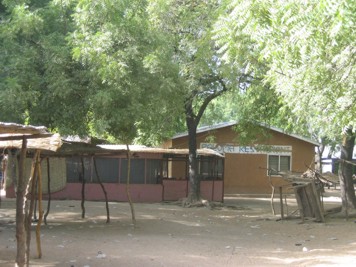
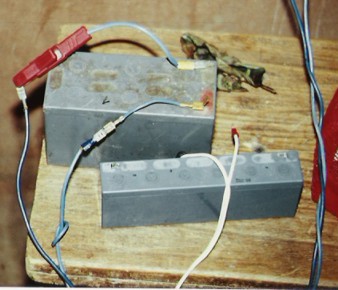
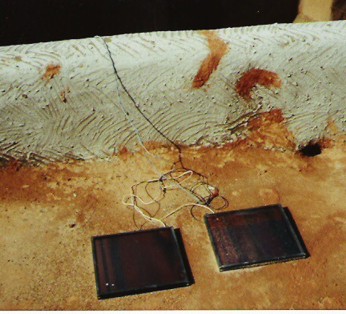 Solar energy: Compared with neighbouring ethnic groups, where solar panels give light to
central places and markets, the Bulsa do not make intensive use of this cheap source of
electricity. Perhaps connection to the mains has cancelled all plans for alternative energy. But
solar energy is still very suitable for compounds too far from the electric lines.
Solar energy: Compared with neighbouring ethnic groups, where solar panels give light to
central places and markets, the Bulsa do not make intensive use of this cheap source of
electricity. Perhaps connection to the mains has cancelled all plans for alternative energy. But
solar energy is still very suitable for compounds too far from the electric lines.
Since 1988 the author has been using two solar panels (on the gbong) with one or two small dry batteries (but an old car battery will do). Solar energy has enabled him to work and read until 10 p.m. and to charge the small batteries for his camera.

Sports: AIf you have worked hard for a whole day, there is no need for sports@. This
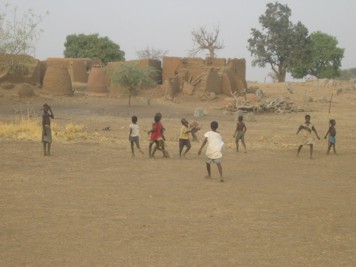 was
what a middle-aged
was
what a middle-aged
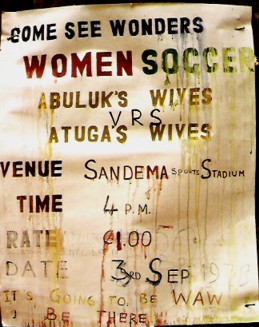 farmer told me in the 1970s. Nevertheless, a big football stadium,
surrounded by high walls, was built in Sandema at that time (see
photo
above). Today football has
more or less conquered the hearts of all young boys and has displaced the traditional gbeli-game, a kind of hockey. In the evening hours you can see schoolboys, shepherds and farm
boys playing football on an untilled site between the compounds (see photo).
farmer told me in the 1970s. Nevertheless, a big football stadium,
surrounded by high walls, was built in Sandema at that time (see
photo
above). Today football has
more or less conquered the hearts of all young boys and has displaced the traditional gbeli-game, a kind of hockey. In the evening hours you can see schoolboys, shepherds and farm
boys playing football on an untilled site between the compounds (see photo).
Long distance races are quite popular, too. On July 7th, 2003, a Marathon Athletic Competition for children under 15 took place between Fumbisi-Kasiesa and Wiaga. Even weight-lifting as a means of body-building could be observed in a traditional compound.
Telecommunication: It was not until 2005 that communication by mobile phone b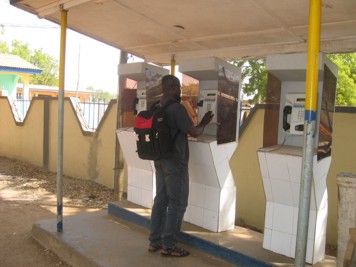 etween
Sandema/Wiaga and
etween
Sandema/Wiaga and

the rest of the world became possible, but only at certain spots in the towns. After the construction of two high transmitting aerials in Sandema in February 2006 see photo), unrestricted mobile phone communication became possible in the north-eastern part of Buluk. The Southern Bulsa, too, can now use their mobile phones, but again only at “certain spots” in their area. Some years before the time of mobile phones, communication centres were opened in Sandema and Wiaga.
Tourism: Although hundreds of visitors from other parts of Ghana and overseas visit the
Bulsa District, there is
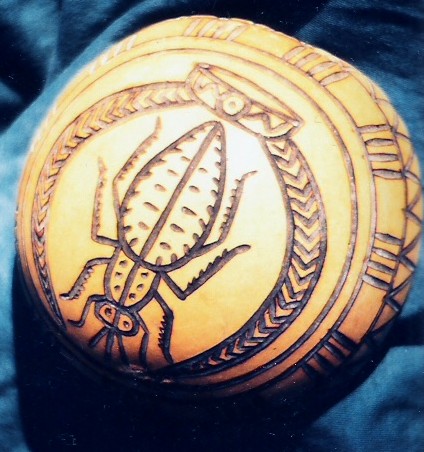 not yet any large-scale tourism in Buluk. Many of them are quite
enthusiastic about their experiences with the land and its people (see report of Renate Ewers
zum Rode in BULUK 1, p. 19). Usually they enter the District on the basis of invitations
through Bulsa friends or they come for a short visit to the Fiok Festival in December. The
Builsa Human Development Report 2004 writes about the chances of tourism (p. 79): AThe
Builsa District has some historical importance and
not yet any large-scale tourism in Buluk. Many of them are quite
enthusiastic about their experiences with the land and its people (see report of Renate Ewers
zum Rode in BULUK 1, p. 19). Usually they enter the District on the basis of invitations
through Bulsa friends or they come for a short visit to the Fiok Festival in December. The
Builsa Human Development Report 2004 writes about the chances of tourism (p. 79): AThe
Builsa District has some historical importance and this can generate some tourism. Public
and donor support are needed for income generating activities@.
this can generate some tourism. Public
and donor support are needed for income generating activities@.
Historical importance is certainly not sufficient for attracting groups of tourists. Certainly,
they (especially those from other countries) might like to visit a traditional com pound or one
of the interesting caverns, in which the Bulsa took refuge during the slave-raids; they might
like to see harmless crocodiles (e.g. those of Kunjiin, Wiaga), as is already possible in Paga.
Many small-sized Bulsa crafts products might find buyers among the tourists, e.g. busik-baskets, ceramic kpaam-kabook vessels, calabash bowls with pyrographic decorations and
drawings (see photo), musical instruments like the gunggong-armpit-drum, the kpanung-lute
(with a calabash- not a tin resonator!), the sinyaara or sinsanguli-basketry rattles, kayagsa-staff rattles and above all the products of the Choabisa brass-casters: chameleon-rings,
coupling chameleons (see photos), pendants, bangles and small figures of human beings and
animals.
pound or one
of the interesting caverns, in which the Bulsa took refuge during the slave-raids; they might
like to see harmless crocodiles (e.g. those of Kunjiin, Wiaga), as is already possible in Paga.
Many small-sized Bulsa crafts products might find buyers among the tourists, e.g. busik-baskets, ceramic kpaam-kabook vessels, calabash bowls with pyrographic decorations and
drawings (see photo), musical instruments like the gunggong-armpit-drum, the kpanung-lute
(with a calabash- not a tin resonator!), the sinyaara or sinsanguli-basketry rattles, kayagsa-staff rattles and above all the products of the Choabisa brass-casters: chameleon-rings,
coupling chameleons (see photos), pendants, bangles and small figures of human beings and
animals.
University Education: In 1973 the four Bulsa students at Cape Coast University could give me the names of all the Bulsa who had ever acquired a university degree. They numbered nineteen. Nearly all of these (including the four Cape Coast students) have had brilliant careers as District Directors, District Chief Executives (DCEs), doctors of medicine, lawyers, lecturers etc. Today the number of Bulsa with a university degree is so high that it is nearly impossible to calculate any exact numbers.
Unemployment: As 93.3% of the “economically active population” of the Bulsa District were “self-employed and unpaid family workers” (2000 Population and Housing Census), it is difficult to find an applicable definition of “unemployment” for Bulsa. Are most farmers unemployed or underemployed in the dry season? “The openly unemployed in Builsa were reported to be 13.8% of the economically active population in 2000 (DHDR 2004, p. 30).

Vulcanizers: A “vulcanizer” is a small mechanical implement, consisting of a base board and a cylinder of a scrapped motor fixed to it. It has been used to mend bicycle tubes by kindling a fire in the cylinder. It is not known where and by whom implements of this kind were invented. They are perhaps typical of the “phase” of booming bicycle transport. Today they have become rare again. Bulsa cyclists now like to use modern small repair kits, with which they can repair a puncture quickly even on the road.
Weaving: Until
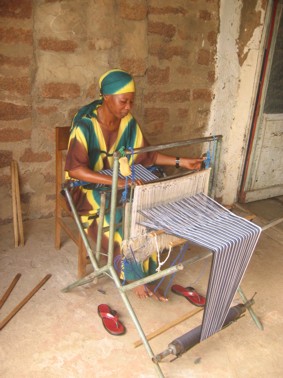 1969 there were some male Yoruba weavers in Sandema, who produced
long woven strips to be sewn together to make the local smock. After the Aliens Compliance
Act (1969) they had to leave Ghana and the Bulsa had to buy their strips or ready made
smocks in non-Bulsa towns (e.g. Daboya or Bawku).
1969 there were some male Yoruba weavers in Sandema, who produced
long woven strips to be sewn together to make the local smock. After the Aliens Compliance
Act (1969) they had to leave Ghana and the Bulsa had to buy their strips or ready made
smocks in non-Bulsa towns (e.g. Daboya or Bawku).
In 2006 there were female Bulsa weavers in Sandema and Wiaga and probably also in some other villages. The looms were smaller than the traditional West African loom and were made of iron. The warp threads were on a warp roller and the finished cloth on a cloth roller. So the long warp threads, burdened with a heavy stone, which are so typical of the West African looms, are no longer necessary and the work at the loom can be done inside a house.
Yams: My impression is that the cultivation of yams has declined since the 1970s, because the harvest results were not quite satisfactory. Nevertheless, today large quantities of yams are offered at the bigger Bulsa markets (e.g. Sandema and Fumbisi) and seem to play a more and more important role for daily meals. Even in traditional compounds sliced yams and yams balls are considered a welcome variation in hot food. In some compounds there are even women who can prepare fufu, a dish typical of Southern Ghana.
Zebu: It was in 2005 when the increasing number of zebus (hunched cows) attracted my attention. Ghana textbooks still describe the hunched cow as typical of the South, the smaller hunchless cattle as typical of the North. The zebu has already attracted the attention of boy artists as objects worth being formed in clay.

